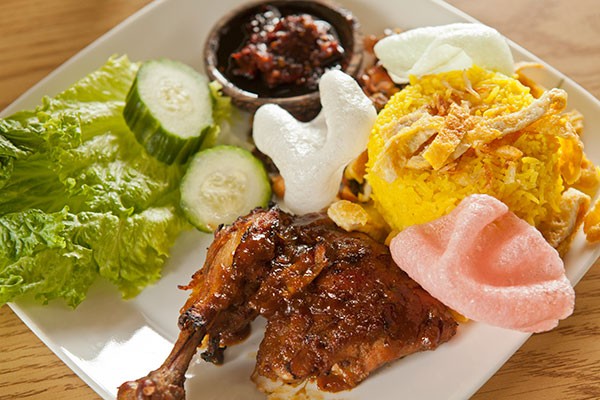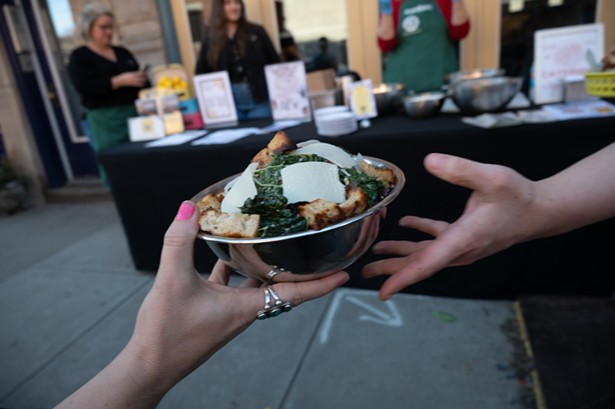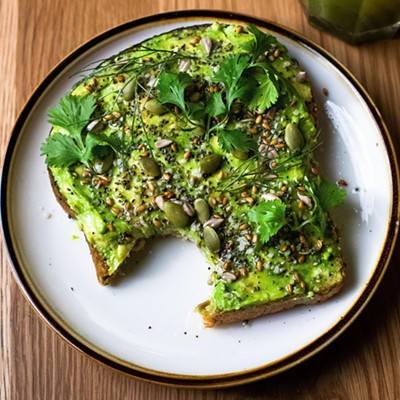The country of Indonesia is comprised of more than 10,000 islands, which has given rise to a thrillingly vibrant and diverse culinary culture. But Indonesian cuisine was not on the menu in Western Pennsylvania until last year. Then, like so many immigrant-borne cuisines, it debuted quietly in a suburban strip mall. Fortunately, Kusuka Indonesian Cuisine's location — right on Route 30 in North Huntingdon — meant that it caught our eye, and we made it a point to return.
Recreating the ambience of an Indonesian eatery in wintry Western Pennsylvania isn't easy, but Kusuka does its best with verdant spring-green paint, colorful posters and shelves of bazaar handicrafts to examine while you wait for your food. The decor is pleasant, but simple; the focus is on the food.
Wisely, Kusuka's menu provides plenty of photographs to assist diners exploring Indonesian dishes for the first time. While the country's indigenous ingredients and preparations have been influenced by neighboring China, India and the Muslim traditions of the Middle East, as well as European trade partners and colonial occupants, diners will find little replication of other cultures' cuisines and much that is new, and distinctly Indonesian, to discover. And while the "Spice Islands" are part of the Indonesian archipelago, Indonesian cooking is not all that spicy, although seasoning is a complex and important part of every dish's flavoring.
We began with several appetizers and a cup of soto ayam, described on the menu as simply "Indonesian chicken soup." Colored yellow with turmeric, the soup contained — in addition to chicken — vermicelli noodles, a quartered hard-boiled egg, and a few vegetables and herbs. It was more brothy than dense, with top notes of flavor and little underlying savor.
Arabic-derived martabak, a popular Indonesian street food served here as an appetizer, folded a straightforwardly flavored, satisfying combination of beef, egg and scallion in a thin, crisp-fried pancake. Tahu goreng — fried tofu prepared in the style of the west Java city of Sumedang — had a robust, crunchy exterior which provided good contrast to the soft, almost creamy interior. A tartly pickled little salad served alongside, consisting of finely diced carrot, cucumber and onion, was a good counterpoint to the tofu's mildness.
Shumai dumplings were dense, firm little fish cakes, and pleasantly savory. They were served with a coarse, deep-brown peanut sauce for dipping that was just a little spicy and not at all sweet. Small morsels of beef satay were tender but meaty and grill-charred. Instead of the peanut sauce that typically comes with Thai satay, Kusuka served a sweet soy sauce studded with tomato and red onion, which provided good balance against the savory meat.
Several variations of mie goreng, or Javanese fried noodles, were on offer, including chicken, lamb, seafood and vegetarian. Thinking of the abundant seafood in the waters around Indonesia's islands, we chose mie goreng with shrimp and calamari. There were lots of vegetables, too — carrot strips, cabbage and bok choy — as well as scrambled egg mixed in with the thick, slightly chewy noodles. The textural pleasures of this dish were great, and the ingredients so plentiful and well distributed that even bites without seafood were satisfying. The overall flavor, however, was perhaps a bit too subtle. Udang goreng mentega, a fried-shrimp dish without either noodles or rice, was prepared in a sweet, smoky, soy-based sauce, rich with butter.
Though not as famous for its curries as India, Indonesia has adapted the Indian spicy stews to its own tradition, with gulai consisting of a rich spice paste cooked in coconut milk. Not surprisingly, different variations are found in different parts of the archipelago. Kusuka's gulai kambing, or lamb curry, had an almost soup-like consistency, in the Javanese tradition, and was full of small chunks of bone-in lamb. While this lent the meat wonderful flavor and tenderness, the bones themselves were difficult to separate, and some fragments were small and sharp. This didn't affect our enjoyment of the dish so much as remindeus that there is good reason many Indonesians prefer their eating with their hands. (In fact, in Indonesia, most tables are set with a spoon and fork, a combination which would have made it near-impossible to eat this gulai kambing.)
In a region waking up to the flavors of a variety of Asian cultures, Kusuka provides a palatable introduction to Indonesian cuisine.













